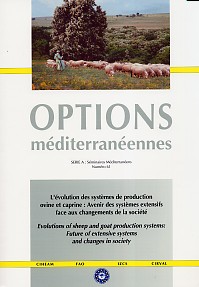| Article précédent | p. 153-160 | Article suivant |
A system analysis of the interaction between wheat crop management and sheep grazing in aftermath stubble
No-till management of rainfed wheat is gaining popularity in semi-arid Mediterranean regions subsequent to improved water utilization, relative to the traditional wheat sowing following soil-discing. However, it is generally associated with straw mulching of the soil, which excludes straw-baling and stubble grazing by sheep. In the Northern Negev of Israel (250 mm of rainfall), during three years of drought, the yield of wheat grain was increased more than 40 per cent by no-till management, but straw mulching had no additive effect. During a “favorable year” (284 mm of rainfall), no effects on grain yield and quality were found for no-till or straw mulching. Dry Awassi ewes consumed daily 1 kg of wheat stubble, less than their requirement for maintenance. Energy expenditure, measured by the heart rate method, was 20 per cent higher in sheep grazing stubble than those fed an iso-energetic diet distributed indoors. Stubble grazing was economically profitable to both wheat growers and sheep-breeders.
- [ Afficher ]
- [ Télécharger ]
- [ Exporter la citation ]
Vous pouvez télécharger la citation au format :
- [ Imprimer ]
-
Mots-clés
DEPENSE ENERGETIQUE, PATURAGE, REGION MEDITERRANEENNE, ZONE SEMI-ARIDECiter cet article
Landau S., Yonatan R., Devash L., Bonfil D.J., Barkai D., Mufradi I., Brosh A. A system analysis of the interaction between wheat crop management and sheep grazing in aftermath stubble. In : Dubeuf J.-P. (ed.). L'évolution des systèmes de production ovine et caprine : avenir des systèmes extensifs face aux changements de la société . Zaragoza : CIHEAM, 2004. p. 153-160. (Options Méditerranéennes : Série A. Séminaires Méditerranéens; n. 61). Séminaire du Sous-Réseau Systèmes de Production du Réseau Coopératif Interrégional FAO-CIHEAM de Recherche et Développement sur les Ovins et les Caprins, 2002/04/04-06, Alghero (Italy). http://om.ciheam.org/om/pdf/a61/04600097.pdf



